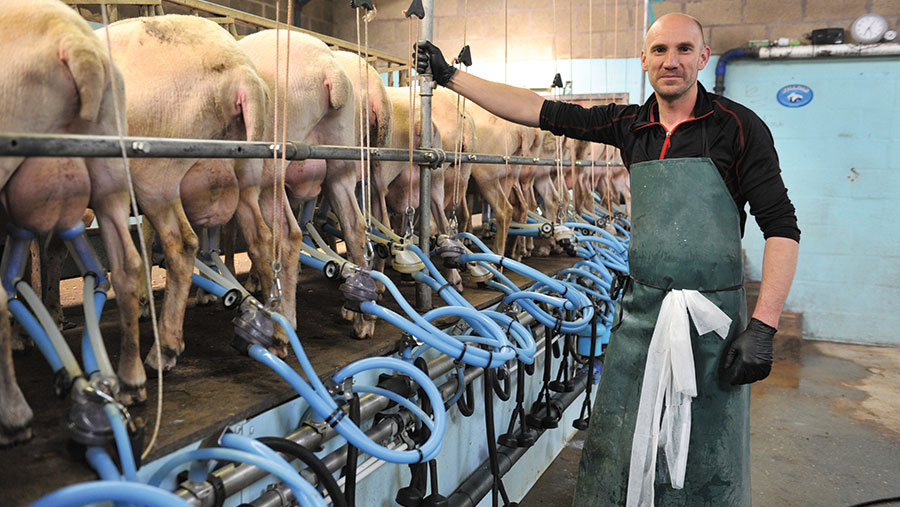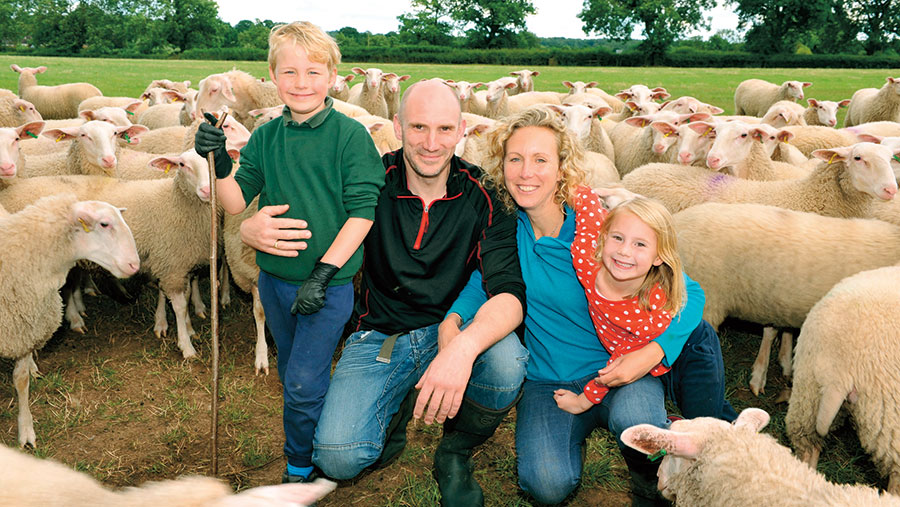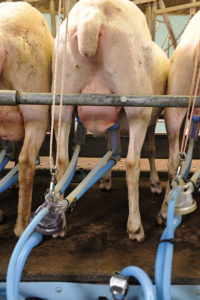How to get good returns from milking sheep
The biggest challenge for anyone embarking on dairy sheep farming is finding a secure and consistent outlet for the milk.
Paul and Laura Mardell established a flock of Friesland milkers on their 31ha county council holding near Coventry, three years ago, but it took them 12 months to secure a contract.
They took the decision to milk sheep because the potential profit margin was attractive and the set-up costs were affordable for a business in its infancy.

On average, the flock produces a daily milk yield of two litres a head at 5.5% butterfat and 5% protein
The sheep milk price is about £1/litre with the cost of production varying from system to system – from 50p/litre to 80p/litre.
See also: How to make a profit from milking sheep
Challenge to secure contract
But securing a supply contract proved more challenging than the Mardells had anticipated.
“We really struggled to find a market for the milk, demand was very sporadic,’’ Mr Mardell recalls. “A buyer would want 1,000 litres one week but nothing the next, it was very hard to get continuity of demand.
“Sheep Milk UK had been buying our milk, but they couldn’t offer us a fixed contract to begin with because there wasn’t enough demand for the milk.”
Sheep Milk UK, a non-profit making farmers’ co-operative, acts as a broker for the milk – selling it to various processors.
The milk is used for producing cheese, yoghurt and ice-cream.
The Mardells secured a contract two years ago and since then they have grown the flock at Musson Hall Farm, Fillongley, from 30 sheep to 180.
County Council farm
They took on the Warwickshire County Council farm in September 2012 and started milking there the following March.
Mr Mardell was working as a dairy consultant at the time and had come into contact with dairy sheep units.
“I’d always had an interest in sheep dairying and when I looked at the sums there was potential to make a good margin,” he says.
“The infrastructure investment was affordable because you don’t need slurry handling facilities with sheep, there is no quota to buy, lower acreage is required, and I pretty much built most of the parlour (a 20:20 direct to line) myself.”

Paul Mardell established a flock of Friesland milkers three years ago
Production
On average, the flock is producing a daily milk yield of two litres a head at 5.5% butterfat and 5% protein.
Mr Mardell does the 5am milking and an agriculture student on a placement year milks at 4pm.
“Laura looks after the lambs and the youngstock and we also have someone who comes in for a couple of hours every other day to do tractor related jobs like moving bales of straw and haylage.”
The milk is stored in a 2,500-litre cooling tank, with milk collected once a week – every Monday – and transported to one of the co-operative’s customers.
The flock grazes during the summer and is mostly housed from November to March, but that depends on weather.
At housing, the flock’s diet is haylage, which is fed ad-lib, and concentrates are fed in the parlour, up to a maximum of 2kg a head a day.

Paul and Laura Mardell with their children
Breeding
Sheep dairying requires specific breeds. The flock at Musson Hall Farm consists of Friesland and Friesland cross Lacaune ewes.
Purebred Friesland rams are used for breeding at a ratio of one ram to 50 ewes.
Rams are purchased from a single source.
The flock is dry from October and the main flock lambs within two weeks in January; the ewe lambs lamb in March and April.
The breed is prolific – last year 30% of the flock had triplets, and 80% lamb unaided.
Lambs are taken off the ewe after 24 hours, after they have received sufficient colostrum, and reared on a milking machine.
After weaning, the gimmers are fed lamb nuts and turned out to grass when they have grown to about 40kg.
The wethers are either sold as stores or as fat lambs, with all January-born lambs sold before June.
The Mardells aim to sell at 40-45kg liveweight but admit they struggle with conformation – the majority achieve O3L grades.
“We sell the lambs at the local markets, but they mostly make £15 to £20 a head less than the average price.
“They don’t seem to sell as well as other lambs, they are quite lean, and the conformation is not as good, but at the end of the day we are in this business to produce milk, not meat,” says Mr Mardell, who also works as ruminant technical manager for GLW Feeds.
Culling
The Mardells want to keep the flock young, so they take a proactive approach to culling, with their replacement rate running between 25%-30%. All ewe lambs are reared for replacements.
“This year we lambed 220 but are now milking 180. We have pulled out any sheep we don’t think will make it,” says Mr Mardell. “If you compare sheep with sheep, Frieslands are fragile compared with other breeds. They don’t like change.”
The two principal causes for culling ewes out of the flock are lameness and mastitis.
Lameness is an issue because the sheep are fed a high level of concentrates.
Frieslands have soft hooves and the sheep do a lot of walking to and from the parlour.
“They are sharing the same surface so there is cross contamination too,” says Mr Mardell.
The main issues are foot-rot and white line separation. To combat these, lime is spread in the feed passages and around the water troughs.
The flock is foot-bathed three times a week, in a solution alternating between a zinc sulphate product and formalin.
Mr Mardell is introducing a mineral package into the compound feed this year, specifically formulated to protect foot health. This will incorporate protected zinc, biotin, vitamin E and yeast.
“We are also looking at including products that help with rumen function to prevent acidosis which can cause problems with feet.’’
A foot-rot vaccination programme will also be introduced this year.

The farm has a strict approach to mastitis
Udder health
A strict approach is also taken with mastitis, with the aim of reducing the incidence of infection.
Mastitis levels vary from year to year – this year there has only been one case, last year there were six, and in the previous year there were three.
Any ewes displaying signs of mastitis are pulled out of the parlour and treated with antibiotics. “We cull these ewes because they never really seem to recover,” says Mrs Mardell.
In the future Mr Mardell says they have the capacity to grow the flock to 350 milking ewes plus youngstock.
With the cow milk industry in turmoil, he says dairy farmers may be tempted to switch from cows to sheep, but he emphasises how important it is to get a buyer in place first.
“It is a golden rule of business that you make sure the demand is there for your product before you produce the supply.”
